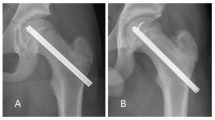Abstract
Purpose
We examined the remodelling of the femoral head–neck junction in patients with slipped capital femoral epiphysis (SCFE) and the frequency of residual cam deformities.
Methods
We reviewed 69 hips in 56 patients with stable SCFE who had undergone in situ pinning. Mean age at slip was 11.7 years and the follow-up period 63.4 months. Cam deformity was evaluated using the anterior offset alpha (α) angle and head–neck offset ratio (HNOR).
Results
The average α angle and HNOR significantly improved from 76.2° to 51.3° and 0.086 to 0.135, respectively; 25 hips (36.2 %) still had an α angle greater than 50°, and 32 hips (46.4 %) had an HNOR of under 0.145. A multivariate analysis selected age at onset and slip angle as risk factors for cam deformity, with cutoff values 11.1 years and 21.0°, respectively.
Conclusions
Although most hips had remodelling of the head–neck junction, 29.4 % had residual cam deformities that may be susceptible to femoroacetabular impingement.




Similar content being viewed by others
References
Boyer DW, Mickelson MR, Ponseti IV (1981) Slipped capital femoral epiphysis. long-term follow-up study of one hundred and twenty-one patients. J Bone Joint Surg Am 1:85–95
Carney BT, Weinstein SL, Noble J (1991) Long-term follow-up of slipped capital femoral epiphysis. J Bone Joint Surg Am 5:667–674
Jones JR, Paterson DC, Hillier TM, Foster BK (1990) Remodelling after pinning for slipped capital femoral epiphysis. J Bone Joint Surg Br 4:568–573
Ganz R, Parvizi J, Beck M, Leunig M, Notzli H, Siebenrock KA (2003) Femoroacetabular impingement: a cause for osteoarthritis of the hip. Clin Orthop Relat Res 417:112–120
Leunig M, Casillas MM, Hamlet M, Hersche O, Notzli H, Slongo T, Ganz R (2000) Slipped capital femoral epiphysis: early mechanical damage to the acetabular cartilage by a prominent femoral metaphysis. Acta Orthop Scand 4:370–375
Goodman DA, Feighan JE, Smith AD, Latimer B, Buly RL, Cooperman DR (1997) Subclinical slipped capital femoral epiphysis. Relationship to osteoarthrosis of the hip. J Bone Joint Surg Am 10:1489–1497
Rab GT (1999) The geometry of slipped capital femoral epiphysis: Implications for movement, impingement, and corrective osteotomy. J Pediatr Orthop 4:419–424
Kamegaya M, Saisu T, Nakamura J, Murakami R, Segawa Y, Wakou M (2011) Drehmann sign and femoro-acetabular impingement in SCFE. J Pediatr Orthop 8:853–857
Loder RT, Richards BS, Shapiro PS, Reznick LR, Aronson DD (1993) Acute slipped capital femoral epiphysis: the importance of physeal stability. J Bone Joint Surg Am 8:1134–1140
Barrios C, Blasco MA, Blasco MC, Gasco J (2005) Posterior sloping angle of the capital femoral physis: a predictor of bilaterality in slipped capital femoral epiphysis. J Pediatr Orthop 4:445–449
Notzli HP, Wyss TF, Stoecklin CH, Schmid MR, Treiber K, Hodler J (2002) The contour of the femoral head–neck junction as a predictor for the risk of anterior impingement. J Bone Joint Surg Br 4:556–560
Pollard TC, Villar RN, Norton MR, Fern ED, Williams MR, Simpson DJ, Murray DW, Carr AJ (2010) Femoroacetabular impingement and classification of the cam deformity: the reference interval in normal hips. Acta Orthop 1:134–141
Eijer H, Myers SR, Ganz R (2001) Anterior femoroacetabular impingement after femoral neck fractures. J Orthop Trauma 7:475–481
Dawes B, Jaremko JL, Balakumar J (2011) Radiographic assessment of bone remodelling in slipped upper femoral epiphyses using klein’s line and the alpha angle of femoral-acetabular impingement: a retrospective review. J Pediatr Orthop 2:153–158
Dobbs MB, Weinstein SL (2001) Natural history and long-term outcomes of slipped capital femoral epiphysis. Instr Course Lect 50:571–575
DeLullo JA, Thomas E, Cooney TE, McConnell SJ, Sanders JO (2007) Femoral remodeling may influence patient outcomes in slipped capital femoral epiphysis. Clin Orthop Relat Res 457:163–170
Bellemans J, Fabry G, Molenaers G, Lammens J, Moens P (1996) Slipped capital femoral epiphysis: a long-term follow-up, with special emphasis on the capacities for remodeling. J Pediatr Orthop B 3:151–157
Westhoff B, Ruhe K, Weimann-Stahlschmidt K, Zilkens C, Willers R, Krauspe R (2012) The gait function of slipped capital femoral epiphysis in patients after growth arrest and its correlation with the clinical outcome. Int Orthop 36(5):1031–1038
Beaule PE, Harvey N, Zaragoza E, Le Duff MJ, Dorey FJ (2007) The femoral head/neck offset and hip resurfacing. J Bone Joint Surg Br 1:9–15
Murray RO (1965) The aetiology of primary osteoarthritis of the hip. Br J Radiol 455:810–824
Zilkens C, Bittersohl B, Jäger M, Miese F, Schultz J, Kircher J, Westhoff B, Krauspe R (2011) Significance of clinical and radiographic findings in young adults after slipped capital femoral epiphysis. Int Orthop 35(9):1295–1301
Kandzierski G, Matuszewski L, Wójcik A (2012) Shape of growth plate of proximal femur in children and its significance in the aetiology of slipped capital femoral epiphysis. Int Orthop 36(12):2513–2520
Clohisy JC, Carlisle JC, Beaule PE, Kim YJ, Trousdale RT, Sierra RJ, Leunig M, Schoenecker PL, Millis MB (2008) A systematic approach to the plain radiographic evaluation of the young adult hip. J Bone Joint Surg Am 90(4):47–66
Author information
Authors and Affiliations
Corresponding author
Rights and permissions
About this article
Cite this article
Akiyama, M., Nakashima, Y., Kitano, T. et al. Remodelling of femoral head–neck junction in slipped capital femoral epiphysis: a multicentre study. International Orthopaedics (SICOT) 37, 2331–2336 (2013). https://doi.org/10.1007/s00264-013-2047-6
Received:
Accepted:
Published:
Issue Date:
DOI: https://doi.org/10.1007/s00264-013-2047-6




